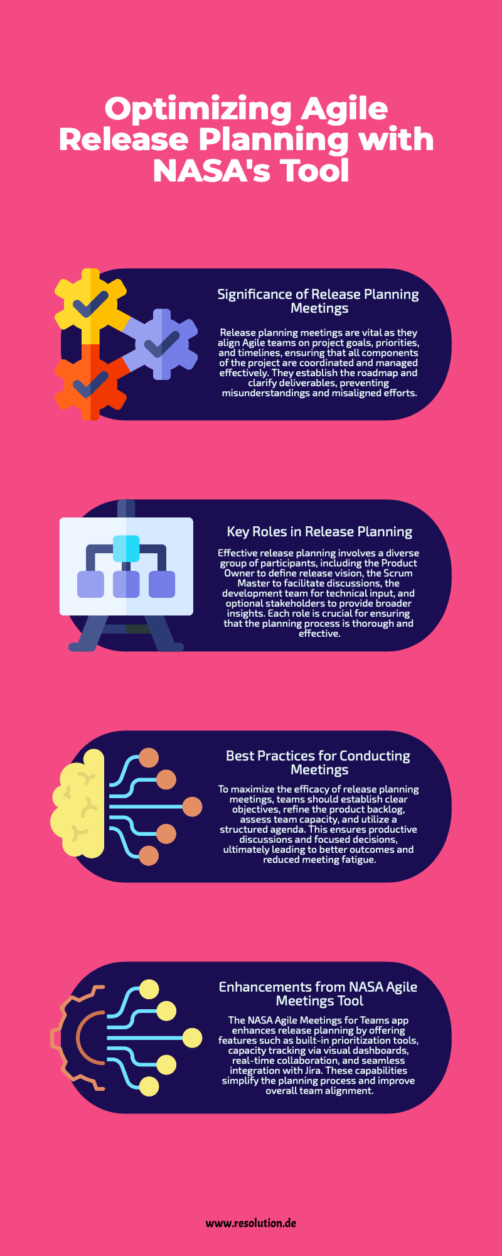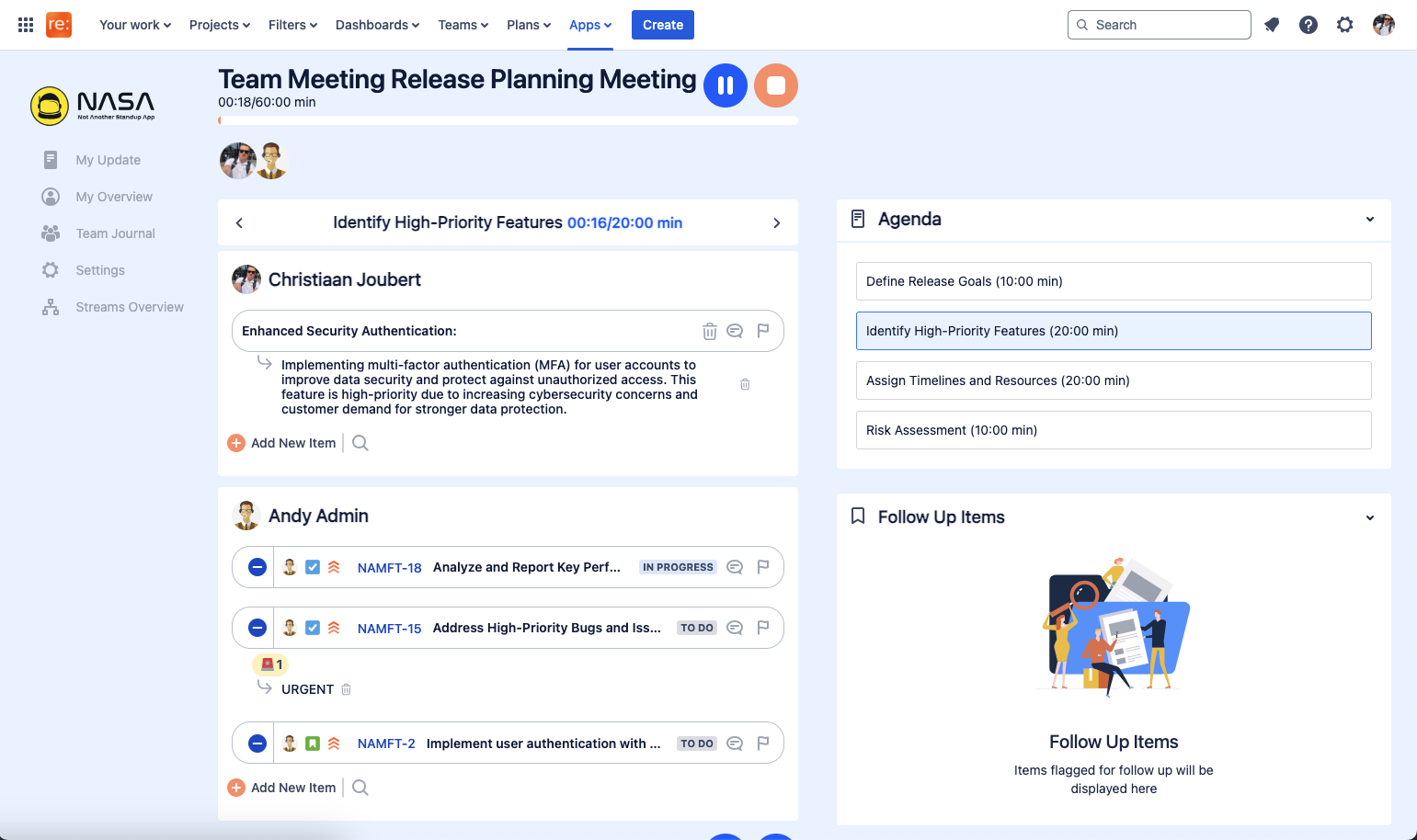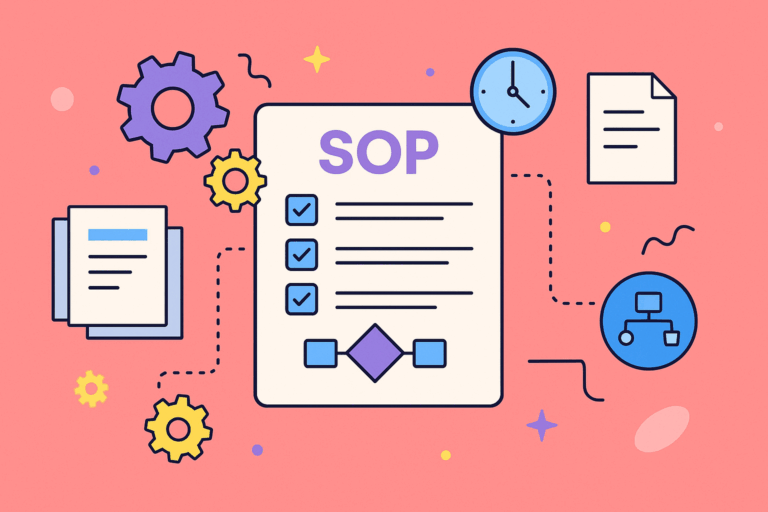In the Agile development world, a release planning template serves as a cornerstone for success. It bridges the gap between strategy and execution, helping teams align their efforts with business goals. Release planning meetings define deliverables, prioritize features, and lay out a roadmap for upcoming iterations, ensuring that all team members share a unified vision.
However, the complexity of orchestrating cross-functional collaboration, managing dependencies, and avoiding scope creep can make effective release planning a challenge. That’s where tools like NASA Agile Meetings for Teams come into play. This blog will explore best practices for a release planning template while highlighting how this innovative app empowers teams to navigate these challenges with precision and clarity.
Key Takeaways
In this article, you’ll learn:
The fundamentals of release planning meetings and their significance in Agile.
The critical roles and responsibilities of participants.
Proven strategies for conducting effective release planning.
How NASA Agile Meetings for Teams transforms the release planning process.
Understanding Release Planning Meetings
Release planning meetings are structured gatherings where Agile teams strategize for an upcoming release. These sessions aim to answer fundamental questions:
What is the goal of this release?
Which features or fixes will deliver the most value?
How do we sequence and schedule tasks to achieve these goals?
The process involves collaboration among key players, including the Product Owner, Scrum Master, and the development team, alongside stakeholders who bring valuable perspectives. These meetings are iterative, meaning teams revisit and adjust their plans to respond to changing priorities or challenges.
Importance of Release Planning
Why is release planning indispensable?
Alignment Across Teams: Without a clear release plan, teams risk working in silos, leading to misaligned priorities and wasted effort.
Customer Satisfaction: A well-planned release ensures that deliverables align with customer expectations and business goals.
Risk Mitigation: A release planning template helps identify and address dependencies or potential blockers early in the development cycle.
Example Pitfall: Consider a team that skips release planning. They might build features that overtax their resources, miss crucial customer needs, or delay delivery due to unforeseen bottlenecks.

Key Objectives of a Release Planning Meeting
A successful release planning meeting should accomplish the following:
Define Release Goals: What will this release achieve? Clear objectives guide the team’s efforts and measure success.
Prioritize Features: Select and sequence the most impactful items from the product strategy backlog.
Assess Team Capacity: Estimate workload across sprints to ensure realistic delivery.
Mitigate Risks: Identify potential issues and create contingency plans.
These objectives drive the team toward strategic, value-driven decisions, preventing distractions or inefficiencies.
Who Should Attend a Release Planning Meeting?
The effectiveness of a release planning meeting depends on the right mix of participants:
Product Owner: Sets the release vision and prioritizes features.
Scrum Master: Facilitates the meeting, ensuring alignment and smooth collaboration.
Development Team: Estimates efforts and identifies technical risks or dependencies.
Stakeholders (Optional): Provide strategic insights or clarify high-level goals.
This diverse group fosters collaboration, aligning technical feasibility with business strategy.
Roles and Responsibilities
Here’s how each role contributes to release planning:
Product Owner: Prepares the backlog and communicates the release’s “why.”
Scrum Master: Creates the meeting agenda, ensures productive discussions, and tracks action items.
Software Development Team: Provides input on task breakdown, workload estimation, and dependencies.
Stakeholders: Offer guidance on market demands or organizational goals.
When these roles are clearly defined, teams avoid confusion and maximize their meeting time.
Preparation Steps for a Release Planning Meeting
Proper preparation ensures a smooth and productive session. Follow these steps:
Refine the Product Backlog: Ensure items are well-defined, prioritized, and ready for discussion.
Review Team Capacity: Account for holidays, overlapping projects, or other commitments.
Gather Market/User Data: Align planning with customer needs and competitive insights.
Set the Agenda: Outline the meeting’s purpose, topics, and time allocation to stay focused.
Pro Tip: Use a pre-meeting checklist to ensure nothing falls through the cracks.
How to Conduct an Effective Release Planning Meeting
Here’s a step-by-step guide to mastering your next release planning session:
Start with the Release Vision: The Product Owner shares the “why” behind the release.
Define Objectives: Establish measurable goals for the release.
Review the Backlog: Collaboratively prioritize features and address dependencies.
Estimate Workload: The team evaluates capacity and estimates story points.
Create a Roadmap: Sequence tasks across sprints and identify key milestones.
Summarize the Plan: Recap the outcomes, assign follow-up tasks, and document decisions.
Best Practice: Keep discussions concise and focus on actionable decisions to avoid “meeting fatigue.”
How NASA Agile Meetings for Teams Enhances Release Planning
The NASA Agile Meetings for Teams app offers cutting-edge features designed to streamline and elevate release planning:
Feature Prioritization: Built-in tools help teams rank items based on business value, technical complexity, or user impact.
Capacity Tracking: Visual dashboards track team capacity over multiple sprints, making it easier to set realistic goals.
Real-Time Collaboration: Remote-friendly tools ensure seamless participation, whether teams are in-office or distributed.
Jira Integration: Syncs effortlessly with Jira, so teams can pull backlog items directly into the app and push updates without duplication.
By simplifying logistics and enhancing visibility, the app allows teams to focus on strategic planning rather than administrative overhead.

Summary
Release planning template is essential for Agile success. It aligns teams, mitigates risks, and ensures that deliverables drive maximum value for customers and stakeholders. Following best practices—like refining the backlog, prioritizing features, and assessing capacity—can transform chaotic meetings into well-orchestrated planning sessions.
With the NASA Agile Meetings for Teams app, release planning becomes not only easier but more impactful. Its feature prioritization, capacity tracking, and Jira integration empower teams to make data-driven decisions and maintain alignment across all phases of development.
Ready to revolutionize your release planning?
Schedule a Demo to see NASA Agile Meetings for Teams in action.
Visit our Product Page to learn more.
Download the App from the Atlassian Marketplace and start your journey toward release planning mastery today.
Frequently Asked Questions
What is the main goal of a release planning meeting?
To align the team on deliverables, priorities, and timelines for an upcoming release.
How often should teams hold release planning meetings?
Typically, release planning happens at the start of each release schedule, often quarterly.
What tools can improve release planning?
Platforms like NASA Agile Meetings for Teams and Jira help streamline collaboration, tracking, and prioritization.
How do you handle scope creep during release planning?
Clearly define priorities upfront, establish a change management process, and involve all stakeholders in discussions.
By following these insights and leveraging the right tools, teams can achieve consistent release success, delivering value to their customers with confidence.
The Best Release Planning Template for Effective Project Management
What is Release Planning?
Definition and importance of release planning in Agile project management
A release planning template is a crucial process in Agile project management that helps teams plan, manage, and deploy new versions of a product.
It involves defining a product vision, strategy, and release goals, and creating a roadmap for future releases.
A release planning template is essential for ensuring that teams deliver high-quality products that meet customer needs and expectations.
Benefits of release planning, including improved team collaboration and reduced stress
Improved team collaboration and communication
Reduced stress and burnout due to clear goals and expectations
Increased flexibility and adaptability to changing requirements
Better quality products and reduced defects
Brief overview of the release planning process
Define product vision and strategy
Map release goals to product vision
Review product backlog and rank features for release
Estimate work and plan release dates
Create a deployment/release sprint
Focus on first release with detailed planning
Agile Release Planning Process
Work with stakeholders to define product vision and strategy
Collaborate with stakeholders to define a clear product vision and strategy
Ensure that the product vision is aligned with the organization’s overall goals and objectives
Define a product roadmap that outlines future releases and milestones
Consider organization’s release capability and map release goals to product vision
Consider the organization’s release capability and limitations
Map release goals to the product vision and ensure that they are aligned
Identify any dependencies or constraints that may impact the release plan
Review product backlog and rank features for release
Review the product backlog and prioritize features for release
Ensure that the features are aligned with the product vision and release goals
Rank features based on business value, customer needs, and technical complexity
Essential Elements of a Release Plan
Work estimation and release date planning
Estimate the work required for each feature and task
Plan release dates based on the estimated work and team velocity
Ensure that the release plan is realistic and achievable
Inclusion of a ‘deployment/release sprint’
Include a deployment/release sprint in the release plan
Ensure that the deployment/release sprint is properly planned and executed
Identify any risks or dependencies that may impact the deployment/release sprint
Focus on first release with detailed planning
Focus on the first release and create a detailed plan
Ensure that the first release is properly planned and executed
Identify any lessons learned and apply them to future releases
Creating an Effective Agile Release Plan
Best practices for release planning, including staggered releases and definition of done
Use staggered releases to reduce risk and improve quality
Define a clear definition of done for each feature and task
Ensure that the release plan is flexible and adaptable to changing requirements
Use of project management software for release planning
Use project management software to support release planning
Ensure that the software is properly configured and used
Identify any benefits or limitations of using project management software
Continuous updating of the release plan
Continuously update the release plan to reflect changing requirements and priorities
Ensure that the release plan is aligned with the product vision and release goals
Identify any risks or dependencies that may impact the release plan
Choosing the Right Release Plan Template
Factors to consider when selecting a release plan template
Consider the team’s size, complexity, and experience
Ensure that the template is flexible and adaptable to changing requirements
Identify any benefits or limitations of using a release plan template
How to choose the best template for your team
Choose a template that is aligned with the team’s needs and goals
Ensure that the template is properly configured and used
Identify any benefits or limitations of using a release plan template
Using a Release Plan Template
Visualize releases in different ways
Visualize releases in different ways, such as using a release calendar or roadmap
Ensure that the visualization is clear and easy to understand
Identify any benefits or limitations of using visualization
Overcoming Common Challenges in Release Planning
Maintaining communication and collaboration
Maintain communication and collaboration among team members and stakeholders
Ensure that the release plan is properly communicated and understood
Identify any benefits or limitations of using communication and collaboration tools
Common obstacles in release planning and how to overcome them
Identify common obstacles in release planning, such as scope creep and unrealistic expectations
Develop strategies to overcome these obstacles, such as using a clear definition of done and prioritizing features based on business value
Release Planning Tools and Software
Features to look for in a release planning tool
Features to look for in a release planning tool, such as release calendar, roadmap, and burndown chart
Ensure that the tool is properly configured and used
Identify any benefits or limitations of using a release planning tool
Applying Release Planning to Software Development
Conclusion
Recap of key takeaways for effective release planning
Recap of key takeaways for effective release planning, such as creating a clear product vision and strategy, using a release plan template, and maintaining communication and collaboration
Ensure that the release plan is aligned with the product vision and release goals
Identify any benefits or limitations of using release planning principles
Frequently Asked Questions
What is the purpose of a release planning meeting in Agile?
A release planning meeting helps Agile teams align on goals, prioritize features, and create a roadmap for upcoming iterations. It ensures that deliverables meet customer needs, team efforts align with business objectives, and potential risks are identified early.
How does the NASA Agile Meetings for Teams app enhance release planning?
The NASA Agile Meetings for Teams app streamlines release planning with features like:
Feature Prioritization: Rank backlog items based on business value and impact.
Capacity Tracking: Visual dashboards help teams manage workload across sprints.
Real-Time Collaboration: Seamless participation for distributed and remote teams.
Jira Integration: Sync backlog items and updates directly with Jira, reducing duplication.
Who should attend a release planning meeting, and what are their roles?
Key participants include:
Product Owner: Defines the vision and priorities for the release.
Scrum Master: Facilitates discussions and tracks progress.
Development Team: Estimates workload, identifies risks, and plans task execution.
Stakeholders (Optional): Provide insights on market demands and strategic goals.
How can teams prevent scope creep during release planning?
Teams can avoid scope creep by:
Clearly defining priorities and release goals upfront.
Implementing a structured change management process.
Regularly involving stakeholders to align on scope changes and their impact.
What are the benefits of using tools like NASA Agile Meetings for Teams over manual release planning?
Tools like NASA Agile Meetings for Teams offer:
Time Efficiency: Automation reduces administrative overhead.
Improved Collaboration: Real-time updates ensure everyone stays on the same page.
Visibility and Tracking: Visual dashboards and Jira integration provide clear progress tracking.
Data-Driven Decisions: Built-in prioritization tools support strategic planning.




